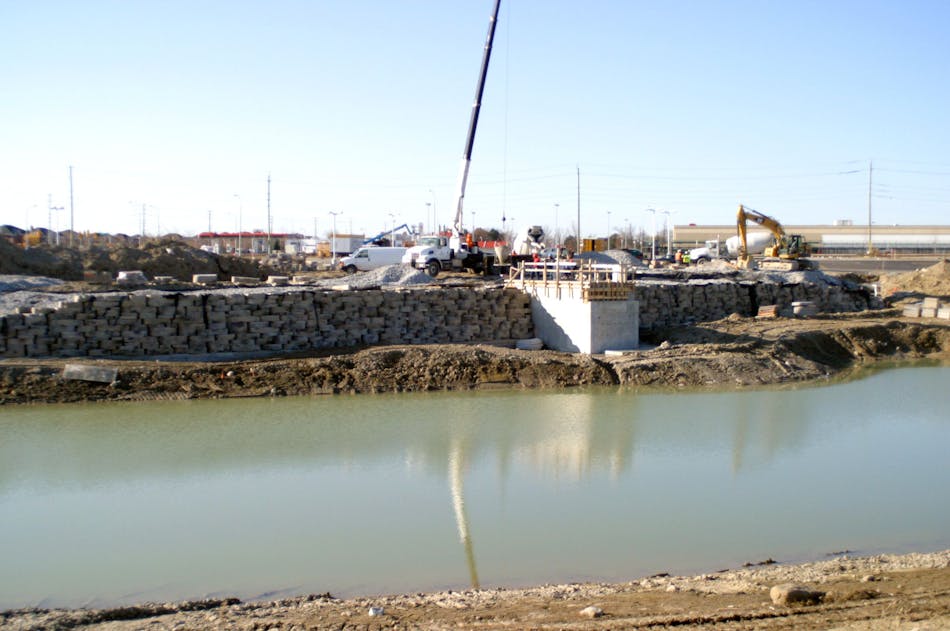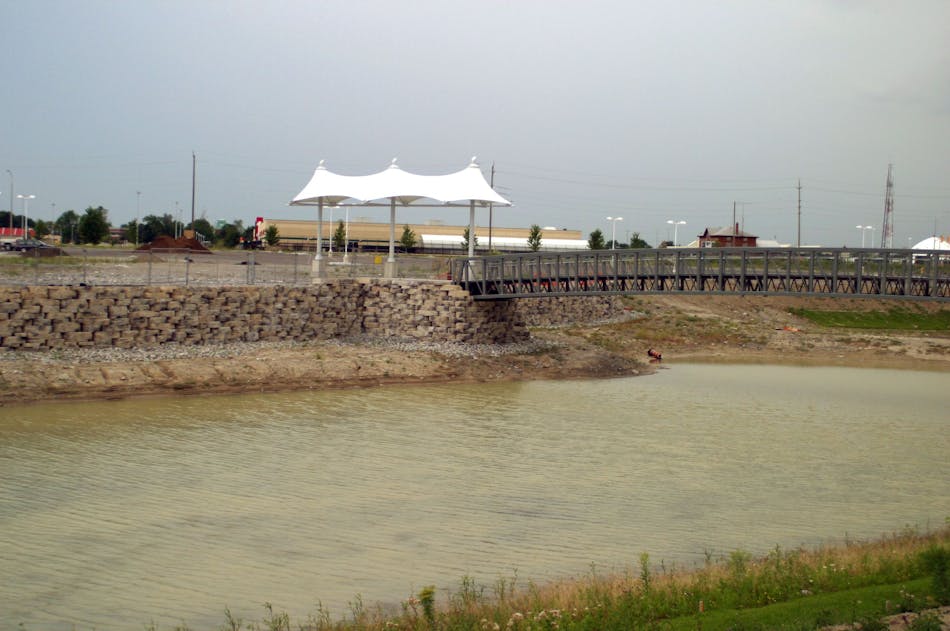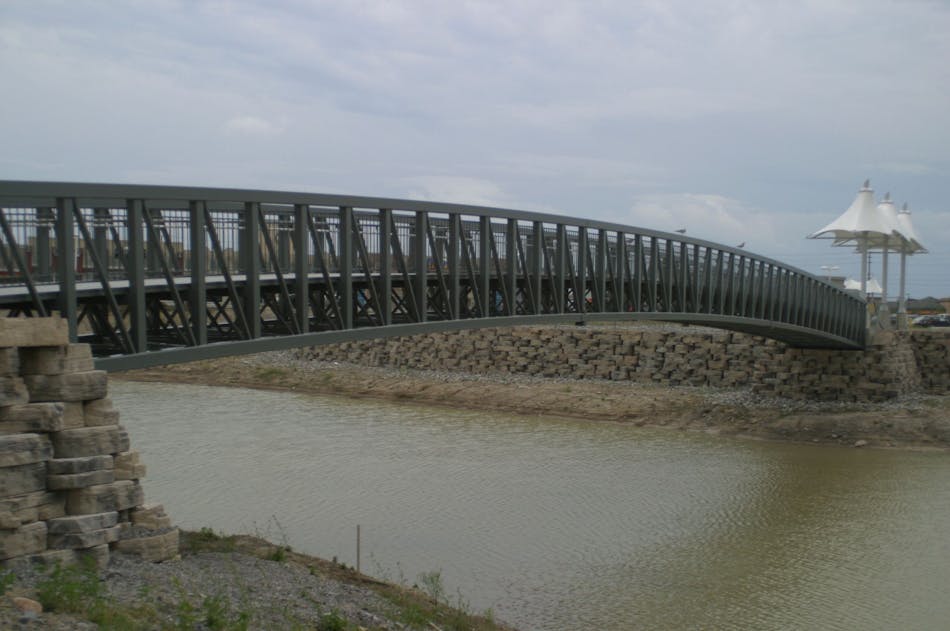THE CHALLENGE
When space is limited, new developments are left with little choice but to put retention ponds in very visible areas. Rather than making retention ponds an aesthetic liability, developers are finding new ways to turn retention ponds into focal points instead.
A Whitby, Ontario development was faced with such a challenge in 2009. When the Taunten Garden Power Centre development is completed, several restaurants will overlook the on-site retention pond. In total, engineers specified 4,000 square feet (372 meters) of retaining walls for the pond-so choosing a structural yet aesthetically pleasing wall system was essential. Initially, developers wanted to line the pond with natural stone; however, the walls needed to be engineered up to 12 feet (3.7 meters) high-a difficult and costly project with natural stone.
THE SOLUTION
For a solution, developers turned to Brown's Concrete Products, Limited-a local manufacturer of Rosetta Hardscapes retaining wall systems. Rosetta's Outcropping Collection is a precast concrete system that combines the natural, random look of outcropping stone with the engineered benefits of a manufactured wall system. The result? Beautiful walls that are easy to engineer and install, without the hassle of sorting, cutting, and costly overruns associated with natural stone.
Michael Canu, President of Invision Landscaping, oversaw the installation of the walls at Taunten Garden and explained the benefit of Rosetta:
"Once you've installed Rosetta you'd never go back to natural stone again," he said. "The sheer fact that it has consistent dimensions and is structural and aesthetic make it a great product to work with. And, there's no wasted time and there's no wasted material."
Rosetta's Outcropping Collection uses 12 unique size units with 24 unique stone textures. Dimensions vary from 24 inches (610 millimeters) to 72 inches (1,829 millimeters) wide and from 6 inches (152 millimeters) to 24 inches (610 millimeters) tall. These relatively large dimensions give walls a natural, believable finish.
The retention pond at Taunten Garden required retaining walls for one simple reason: the developer needed to reduce the retention pond footprint to allow enough space onsite to build the desired buildings. During a rainstorm, nearby bodies of water could not handle the amount of runoff from the parking lots and roofs within the development. To prevent flooding, the water needed to be held in a retention pond until it could be released into the appropriate water system. With regular rising and falling water levels, the side slopes of the pond needed to be very gradual or else they would quickly erode and become unsightly; however, the gradual slopes significantly increased the pond footprint. The retaining walls were used to create near vertical walls on one side of the pond and therein provide room for two additional buildings.
In total, engineers designed the Rosetta walls to stand 12-feet (3.7-meters) high at the tallest point. The bulk of the wall was reinforced with Paraweb strap, though several sections of the wall were designed as gravity walls, relying on the mass of the blocks for structural stability.
Due to the poor condition of the native soils, the base of the wall consisted of a 3.3-foot (1-meter) thick concrete leveling pad. To help keep costs down, the bottom 5 feet (1.5 meters) of the wall structure was built using the Grande® retaining wall system which was already being used elsewhere on-site. This portion of the wall will remain below the water line. To integrate the Grande system with the Rosetta Outcropping system, Invision Landscaping's crew left a 6 inch (152 millimeter) gap behind the Grande wall so that when they began installing Outcropping blocks, they could engage the shear heels on the back of each Outcropping block.
The number one cause of retaining wall failure is hydrostatic pressure build up behind a wall as water drains. To prevent this, engineers took special precautions when designing the walls. Backfill consisted of compacted, crushed rock that extended behind the wall to the limit of excavation. Installing perforated drainage pipe with a sock, day lighting every 10 feet (3 meters), at a 2 percent grade allowed the Outcropping walls to drain properly.
The retention pond design also included a bridge that crossed over the top of the pond, with two concrete bridge piers standing on either side of the pond. Next to the Outcropping lining the pond, the bridge piers looked harsh and out of place, so the developer decided to face the piers with Rosetta. Installers reinforced the walls by tying the walls to the concrete piers using Paraweb strap.
This was one of the first projects that utilized the Outcropping Collection's A Corner option. This design feature prevented repetitive appearance in the corner of walls, lending a more natural look to the finished project.
THE OUTCOME
The retention pond walls were completed in 2009, and construction of restaurants and stores were completed in 2011.
The Taunten Garden retention pond is a textbook example of creating a retention pond that is attractive enough to act as a focal point for a development.
PROJECT DETAILS
Project: Taunten Garden Retention Pond Customer: Taunten Garden Power Centre Design / Specifying Engineer: Sigmund Kirchhefer Limited Block Manufacturer: Brown's Concrete Products, Limited Wall Installer: Invision Landscaping Project Location: Whitby, Ontario Year: 2009 Case: 029 - Taunten Gardens Retention Pond



